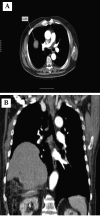Lightning strike: a first case of unilateral diaphragmatic paralysis
- PMID: 24765394
- PMCID: PMC3981430
- DOI: 10.4081/cp.2011.e94
Lightning strike: a first case of unilateral diaphragmatic paralysis
Abstract
Lightning injury is the second most common cause of weather-related deaths in the United States. Despite the several neurological complications such as polyneuropathy, myelopathy, spinal cord injury, motor neuron disease due to the lightning-induced injury, there is no documented case of unilateral diaphragmatic paralysis. We describe the case of a patient with a history of lightning strike at childhood period, prior the onset of isolated, diaphragmatic paralysis, unilaterally. Clinical and electrophysiological findings suggest an injury restricted to the phrenic nerve, unilaterally.
Keywords: diaphragmatic paralysis.; lightning injury; phrenic nerve.
Figures



Similar articles
-
[Lightning strike and lesions outside the brain: Clinical cases and a review of the literature].Rev Neurol (Paris). 2015 Jan;171(1):75-80. doi: 10.1016/j.neurol.2014.08.001. Epub 2014 Oct 13. Rev Neurol (Paris). 2015. PMID: 25444447 Review. French.
-
Physiological changes and compensatory mechanisms by the action of respiratory muscles in a porcine model of phrenic nerve injury.J Appl Physiol (1985). 2021 Mar 1;130(3):813-826. doi: 10.1152/japplphysiol.00781.2020. Epub 2021 Jan 14. J Appl Physiol (1985). 2021. PMID: 33444121
-
PARAPARESIS FOLLOWING PERIPHERAL AND CENTRAL NERVOUS SYSTEM LESIONS AFTER A LIGHTNING STRIKE - A CASE REPORT.J Rehabil Med Clin Commun. 2025 Apr 1;8:42545. doi: 10.2340/jrm-cc.v8.42545. eCollection 2025. J Rehabil Med Clin Commun. 2025. PMID: 40201416 Free PMC article.
-
Unilateral diaphragmatic paralysis in spinal cord injury patients.Paraplegia. 1980 Aug;18(4):267-74. doi: 10.1038/sc.1980.46. Paraplegia. 1980. PMID: 7422343
-
Modern concepts of treatment and prevention of lightning injuries.J Long Term Eff Med Implants. 2005;15(2):185-96. doi: 10.1615/jlongtermeffmedimplants.v15.i2.60. J Long Term Eff Med Implants. 2005. PMID: 15777170 Review.
References
-
- Courtman SP, Wilson PM, Mok Q. Case report of a 13-year-old struck by lightning. Pediatr Anesth. 2003;13:76–9. - PubMed
-
- Whitcomb D, Martinez JA, Daberkow D. Lightning injuries. South Med J. 2002;95:1331–4. - PubMed
-
- Edlich RF, Farinholt HM, Winters KL, et al. Modern concepts of treatment and prevention of lightning injuries. J Long Term Eff Med Implants. 2005;15:185–96. - PubMed
-
- Halldorsson A, Couch MH. Pneumomediastinum caused by a lightning strike. J Trauma. 2004;57:196–7. - PubMed
-
- Van Spijker RC, Monasch E, Compier-Mahboob N, Merkies IS. Neurological symptoms following lightening strike. Ned Tijdschr Geneeskd. 2009;153:A774–A774. - PubMed
Publication types
LinkOut - more resources
Full Text Sources

